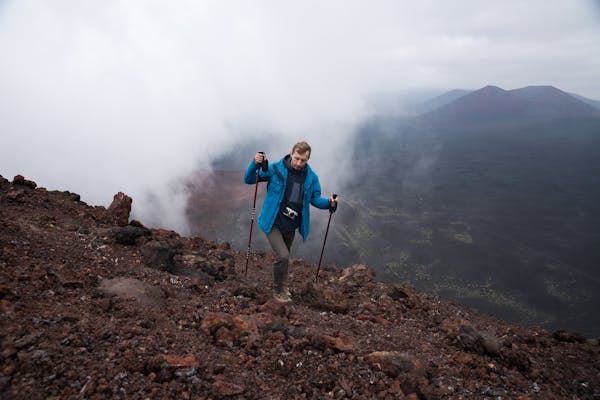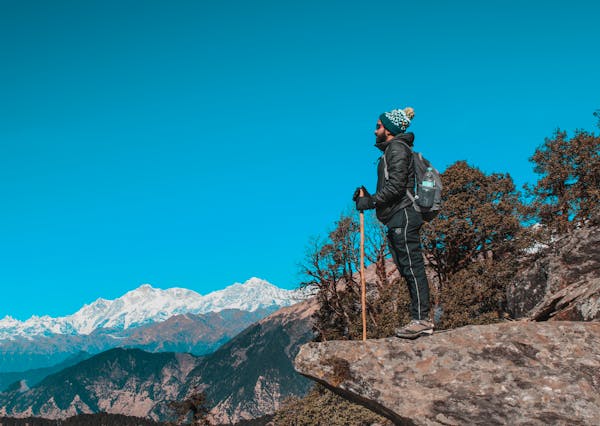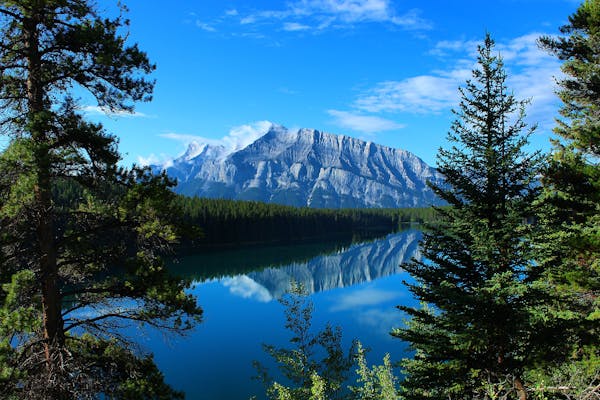Do I Need Hiking Sticks in Blue Lakes Breckenridge? Hiking sticks can be helpful when exploring Blue Lakes in Breckenridge. They give firmness on uneven terrain, especially on steep ascents and descents. Using hiking sticks can also minimize knee strain, making your hike more comfortable and pleasant. These will be helpful on longer hikes that are on the steeper side. They’ll be good if you have bad knees when going downhill and give you something to lean on when going up the hills.
Considerations for Not Using Hiking Sticks in Blue Lakes
While hiking sticks can be helpful, they aren’t always necessary for everyone. The Blue Lakes trail is relatively grueling, and endured trampers might find they can manage without them. However, you can choose to hike without sticks, If you prefer to keep your hands free.
Hiking Dolomites Mountains Italy Should You Bring Hiking Sticks?

Advantages of Hiking Sticks in the Dolomites Mountains
Hiking sticks are largely recommended when hiking the Dolomites Mountains in Italy. The steep trails and rocky terrain can be grueling, and sticks help maintain balance. They also prop in navigating narrow paths and steep descents more safely.
Do I Need Hiking Sticks in Blue Lakes Breckenridge?
Key Benefits of Hiking Sticks at Blue Lakes Breckenridge
- Increased Stability: Helpful on uneven terrain, steep ascents, and descents.
- Knee Support: Reduces knee strain, particularly during downhill sections.
- Weight Distribution: Assists with carrying heavy loads for more comfortable hikes.
When to Consider Not Using Hiking Sticks
- Trail Familiarity: Experienced hikers on well-maintained paths may not need them.
- Preference for Free Hands: Opt for no sticks if you prefer a lighter, unencumbered hike.
Hiking in the Dolomites Mountains, Italy: Are Hiking Sticks Needed?
Advantages of Hiking Sticks in the Dolomites
- Navigating Steep, Rocky Terrain: Essential for stability on challenging, uneven trails.
- Support on Narrow Paths: Adds balance on sharp inclines and descents.
When Hiking Sticks Might Not Be Necessary in the Dolomites
- Smoother Trails: Easier routes (e.g., Alpe di Siusi) may not require sticks.
- Experienced Hikers: Seasoned hikers on flatter sections can manage without them.
When You Can Skip the Hiking Sticks in the Dolomites
Although hiking sticks are helpful, educated trampers might choose to avoid them on easier routes. Some trails in the Dolomites, similar to those around Alpe di Siusi, have smoother paths. However, hiking sticks may not be essential if you feel confident with your footing.
Pros and Cons of Hiking Sticks for Blue Lakes Breckenridge
| Pros | Cons |
| Enhanced stability | Adds extra weight |
| Reduces knee fatigue | May interrupt natural rhythm |
| Useful for heavy loads | Unnecessary on smooth trails |
Pros How Hiking Sticks Can Ameliorate Your Blue Lakes Hike
Using hiking sticks in Blue Lakes Breckenridge can ameliorate your stability, especially on uneven paths. They help distribute weight and can reduce fatigue in the legs. For those hiking with a pack, sticks offer added support, making it easier to carry heavy loads.
Cons Situations When Hiking Sticks Might Not Be Demanded in Blue Lakes
For short hikes or well-maintained sections, hiking sticks may not be necessary in Blue Lakes. However, you can skip them, If you prefer a featherlight hike without redundant gear. Some trampers also feel that using sticks can intrude with their natural meter.
Do I Need Hiking Sticks for Long-Distance Trails in the Dolomites?

Why Long-Distance Hikes in the Dolomites Benefit from Hiking Sticks
Long-distance hikes in the Dolomites Mountains, Italy, frequently involve grueling terrain with steep climbs and descents. Hiking sticks help reduce fatigue by furnishing redundant support. They can also be useful for swash crossings or when navigating snow-covered trails.
When You Can Leave Hiking Sticks Behind on Long-Distance Hikes
For some long-distance trampers, carrying hiking sticks can feel like an added burden. However, you might manage fine on flatter stretches, If you are used to hiking without them. On easier parts, similar to lower-altitude trails, you can leave your hiking sticks before.
Using Hiking Sticks for Knee Support at Blue Lakes Breckenridge
How Hiking Sticks Help with Knee Support in Blue Lakes
The trails at Blue Lakes Breckenridge involve some elevation changes, which can strain your knees. Hiking sticks can help spread your body weight, reducing pressure on your joints. They are especially useful when descending steep sections of the trail.
Alternatives to Hiking Sticks for Knee Support in Blue Lakes
still, knee braces, or contraction sleeves can also give support If you prefer not to use hiking sticks. Stretching ahead and after your hike helps help knee pain. Proper footwear with a good bumper can also reduce the impact on your knees.
When Hiking the Dolomites Mountains in Italy, Consider the Terrain
Why Terrain Matters for Hiking Stick Operation in the Dolomites
The rugged terrain of the Dolomites makes hiking sticks a precious tool. The rocky paths and sharp inclines can be easier to navigate with added stability. Hiking sticks help keep your balance on loose clay and steep pitches.
Trails in the Dolomites Where Hiking Sticks May Not Be Essential
Certain trails in the Dolomites, similar to those around Lake Misurina, are fairly flat and well-maintained. On these paths, hiking sticks may not be as pivotal. For educated trampers, shorter routes may not bear the fresh support that sticks give.
Are Hiking Sticks Necessary for Steep Trails in Blue Lakes Breckenridge?

How Hiking Sticks Help on Steep Trails at Blue Lakes
The Blue Lakes trail in Breckenridge includes steep sections that can be grueling. Hiking sticks give redundant influence, making climbs more manageable. They also help reduce strain on the legs during descents, making them a useful tool for steep paths.
When You Can Attack Steep Trails at Blue Lakes Without Hiking Sticks
For fit and endured trampers, steep sections of Blue Lakes may not bear hiking sticks. However, you can manage the climbs with proper footwear, If you prefer to keep your hands free. Those comfortable with hiking in mountainous areas may not need the redundant stability.
Comparing Hiking Conditions Blue Lakes Breckenridge vs. Dolomites Mountains Italy
How Blue Lakes and the Dolomites Differ in Hiking Terrain
Blue Lakes features a blend of gentle and steep trails, while the Dolomites are known for rugged, grueling terrain. Hiking sticks are helpful in both locales, but the need for them is lesser in the Dolomites. The rocky and high-altitude paths in Italy bear further support.
What Blue Lakes and the Dolomites Have in Common for Trampers
Both Blue Lakes and the Dolomites offer stunning decor and trails suitable for different skill situations. In both places, hiking sticks can enhance your experience, furnishing balance and stability. Whether you bring them depends on your comfort position and trail difficulty.
Do I Need Hiking Sticks for Day Hikes in the Dolomites Mountains Italy?
Benefits of Hiking Sticks for Day Hikes in the Dolomites
Hiking sticks are useful indeed on shorter day hikes in the Dolomites. They give stability on uneven paths and can help conserve energy. For day hikes with steep ascents, hiking sticks can make the experience more comfortable.
When Day Hikes in the Dolomites Don’t Bear Hiking Sticks
Some easy trails in the Dolomites are suitable for hiking without sticks. However, hiking sticks may not be demanded, If you’re diving well-pronounced and fairly flat paths. For those who prefer lighter gear, skipping hiking sticks can make for a more debonair hike.
Are Hiking Sticks Useful for Hiking in Both Summer and Downtime?
How Hiking Sticks Help in Summer at Blue Lakes and the Dolomites
In summer, hiking sticks offer support on dry, rocky trails at both Blue Lakes and the Dolomites. They help with stability on loose clay and steep pitches. Sticks can also help with navigating grown paths, making summer hikes safer and easier.
Using Hiking Sticks in Winter for Snowy Trails at Blue Lakes and the Dolomites
During downtime, hiking sticks are largely recommended for snowy and icy trails in the Dolomites and Blue Lakes. They help maintain balance on slippery shells. Using hiking sticks with snow baskets ensures better grip and prevents sinking into deep snow.
Hiking Sticks vs. Touring Poles What’s Stylish for Blue Lakes and the Dolomites?
Why Some Trampers Prefer Touring Poles for Blue Lakes and the Dolomites
Touring poles are frequently malleable and can be used on colorful terrains. They give analogous benefits to hiking sticks, like balance and weight distribution. For trails with mixed conditions, similar to rocky paths or snow, touring poles are protean tools.
Situations Where Traditional Hiking Sticks May Be Further Suitable
Some trampers prefer traditional hiking sticks for their continuity and stability. Fixed-length hiking sticks can be ideal for harmonious terrain, similar to the grassy paths of Blue Lakes. They’re frequently sturdier than constringing touring poles, making them a good choice for steep ascents.
Should You Rent or Buy Hiking Sticks for the Dolomites Mountains, Italy?

Advantages of Renting Hiking Sticks in the Dolomites
Renting hiking sticks in the Dolomites is an accessible option, especially for trippers. It saves you from carrying redundant gear on your flight. Numerous original shops near popular hiking areas offer rental services at affordable rates.
When Buying Hiking Sticks May Be a Better Investment
still, buying your hiking sticks may be worthwhile, If you plan on hiking constantly. It allows you to choose a brace that suits your specific requirements and preferences. Retaining your own sticks ensures you always have them ready for your coming adventure.
How to Choose the Right Hiking Sticks for Blue Lakes Breckenridge
Factors to Consider When Picking Hiking Sticks for Blue Lakes
When opting for hiking sticks for Blue Lakes, consider the weight and adjustability. snippersnapper, malleable sticks make it easier to acclimatize to different sections of the trail. Look for hiking sticks with comfortable grips and good shock immersion for a stylish experience.
Popular Hiking Stick Brands for Blue Lakes and Beyond
Brands like Leki and Black Diamond are well-known for their high-quality hiking sticks. They offer colorful models suitable for different types of hikes, including those at Blue Lakes. Choosing an estimable brand ensures continuity and performance on the trails.
Exploring the Benefits of Hiking Sticks formulate-Day Treks in the Dolomites.
How Hiking Sticks Help onMulti-Day Treks in the Dolomites Mountains, Italy
Hiking sticks give stability during long hikes and can reduce muscle fatigue. They help with maintaining a steady pace on steep and rocky trails. Formulti-day journeys, sticks are useful for managing the redundant weight of a pack.
Alternatives to Hiking Sticks for Long Treks in the Dolomites
still, knee support braces or touring shoes with ankle support can help, If you prefer not to use hiking sticks. Featherlight packs also reduce strain on your legs. These druthers allow you to hike comfortably without carrying redundant gear.
Using Hiking Sticks to Cross Aqueducts in Blue Lakes and the Dolomites
Why Hiking Sticks Are Useful for Stream Crossings
Crossing aqueducts can be grueling, but hiking sticks offer stability by furnishing redundant contact points. They help you maintain balance on slippery jewels. This is particularly useful in places like Blue Lakes, where sluice crossings are common.
Tips for Crossing Aqueducts Without Hiking Sticks
still, use natural supports like large jewels or tree branches, If you don’t have hiking sticks. Take a laggardly, deliberate way to avoid slipping. Wearing leakproof shoes ensures your bases stay dry, indeed if you lose your balance.
FAQs
Q: Do I need hiking sticks for Blue Lakes Breckenridge?
A: Yes, they can improve balance on steep, uneven sections and support your knees.
Q: Are hiking sticks essential for all trails in the Dolomites?
A: No, easier paths like Alpe di Siusi might not need them, though they’re beneficial on steeper routes.
Q: Can I rent hiking sticks for the Dolomites?
A: Yes, many local shops offer rental options, ideal for travelers.
Q: What alternatives exist if I don’t want to use hiking sticks?
A: Consider knee braces, trekking shoes with ankle support, or lightweight packs for longer hikes.
Conclusion
Whether you need hiking sticks for Blue Lakes Breckenridge or the Dolomites Mountains in Italy depends on your comfort and the specific trails. Hiking sticks can enhance your experience by furnishing stability, reducing fatigue, and making delicate terrain more manageable. By considering the trail conditions, season, and your hiking style, you can decide if hiking sticks are right for your coming adventure.
[sp_easyaccordion id=”405″]


[…] in the cold needs careful preparation, especially when it comes to choosing the right winter hiking clothes and gear. In this principle, I’ll walk […]
[…] variety of geographies makes the Dolomites a great destination for all types of trampers. You’ll encounter high-altitude meadows, rugged […]
[…] Do Shelties Make Good Hiking Dogs A Complete Guide. The Shetland Sheepdog, or Shellie, is a small but active herding canine known for its intelligence, dedication, and high energy. multitudinous canine suckers considering a hiking companion might wonder,” Do Shelters make good hiking dogs A complete guide” In this companion, we’ll explore why Shelters are well-suited for out-of-door adventures, what to consider before taking them on a hike, and tips for ensuring a safe and enjoyable experience on the trail. […]
[…] exposed, which can make strong winds particularly dangerous. High winds increase the threat of losing balance, especially on crests or near steep drops. Beech mountain trailhead danger. It’s important to keep […]